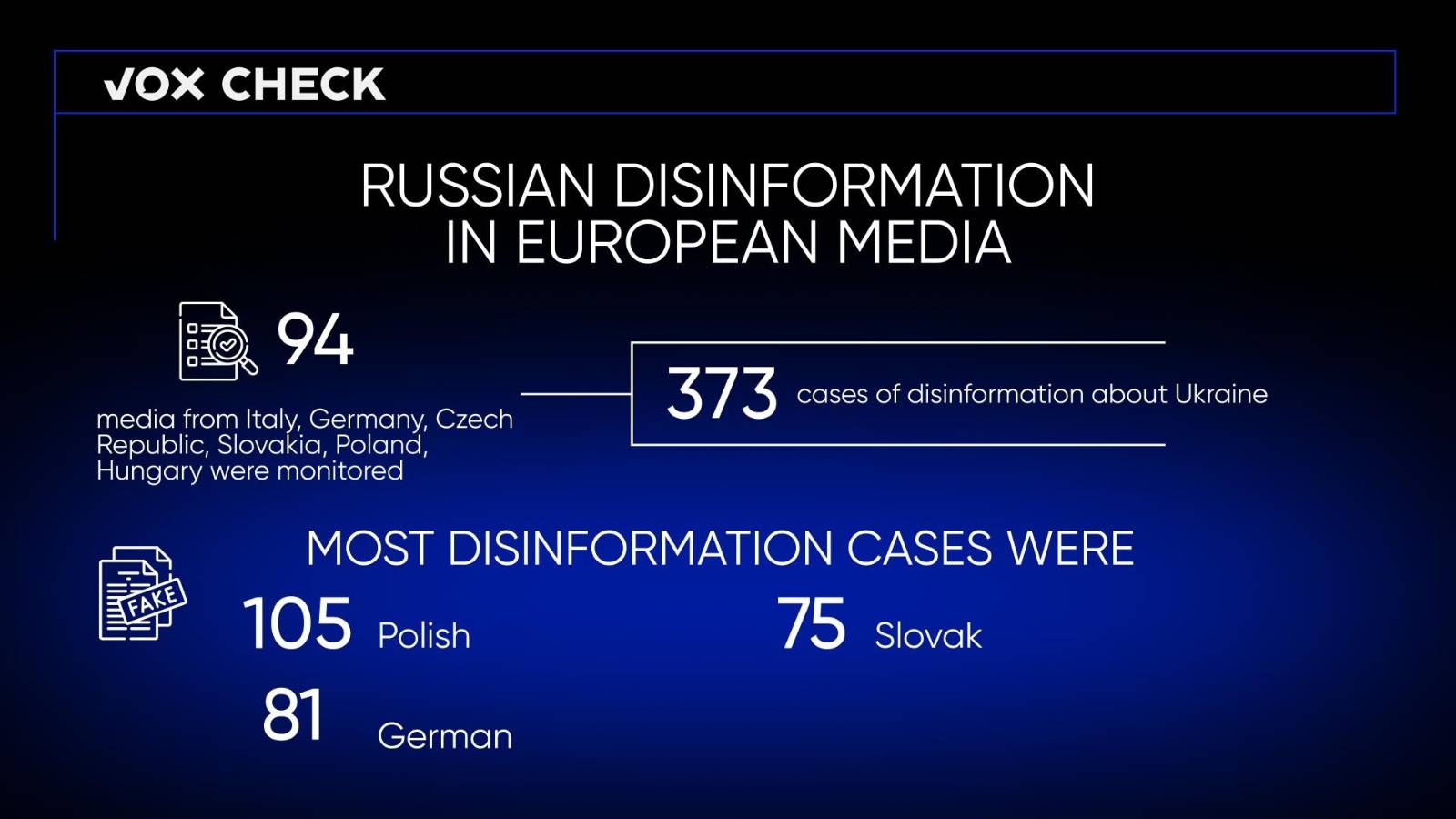In October 2022, VoxCheck monitored 94 media from Italy, Germany, the Czech Republic, Slovakia, Poland, and Hungary and found 373 cases of disinformation about Ukraine. We found the most cases of disinformation in Polish (105), German (81), and Slovak (75) media. In October, the most actively promoted in the European media kremlin’s narratives were that Ukraine is a “terrorist state”; the Ukrainian army commits numerous war crimes against the civilian population; and russia’s aggression against Ukraine is fully justified.
VoxCheck monitors the media in European countries (Germany, Italy, the Czech Republic, Slovakia, Poland, and Hungary) and analyzes the disinformation narratives about Ukraine spread by these media. For the most part, the detected fakes and manipulations are consistent with the main narratives of russian disinformation campaigns. Every month, the VoxCheck team publishes a report on the monitoring results. All disinformation messages, grouped into narratives and their refutations, will be displayed on the “Propaganda diary” database website.
Poland
While monitoring 8 Polish mass media, we discovered 105 cases of disinformation, which we grouped into 11 narratives. Most cases were related to the narratives that the crisis in Europe and the whole world started because of Ukraine (17 cases), the West controls Ukraine and uses it for its own purposes (17 cases), Ukraine is a “terrorist state” (16 cases), and russian aggression is justified (15 cases).
Blaming Ukraine for the emergence of the crisis, the media write about the negative impact of sanctions against the russian federation on the European economy. Allegedly, the West’s economic pressure tools did not work against russia, and now, due to a series of financial restrictions, the entire region is forced to suffer because of Ukraine’s support. In addition, the mouthpieces of propaganda in Poland write that the US is using this war to weaken Europe and solve its own problems economically.
Polish mass media also promote the narrative that the West controls Ukraine and uses it for its own purposes and writes as if Ukraine lacks subjectivity, instead, it is only a tool for creating a russophobic ideology and fighting against russia. There were also theses that the West is deliberately prolonging the war, and Ukraine is ruled by American advisers, on whose will the political future of Volodymyr Zelenskyi depends.
The conspiracy theory that the “Anglo-Saxons” are planning to blur the national identity of Poland, make it a multinational state by populating it with Ukrainian refugees, and thus form a sanitary border between Germany and Russia has become unique to the Polish media sphere.
In addition to the traditional fakes about Nazism in Ukraine (a total of 13 cases about Nazism were found), Polish-language sources wrote that Ukrainians are hostile not only to russians but also to Poles. And they seem to be already spreading Nazi symbols in Polish cities.
There was also another important narrative — Ukrainians allegedly want to join russia (10 cases). The media multiple times repeated the russian myth that “Ukrainians and russians are a single nation” and called participation in pseudo-referendums in the occupied territories of Ukraine “an expression of the will of the people.”
Slovakia
In October, we analyzed 11 Slovak media and collected 75 cases of disinformation. They can be divided among 15 russian propaganda narratives. The narratives related to the full-scale invasion of the russian federation into Ukraine became the largest in terms of the number of examples. Yes, we found the most fakes about Ukraine allegedly losing the war (19 cases), russian is being justified (13 cases), and Ukraine is a “terrorist state” (8 cases).
When talking about Ukraine’s “loss” in resisting russian aggression, the Slovak media recounted typical russian informational biases: allegedly, the Ukrainian leadership neglects human losses at the front and “does not know the art of war”, the servicemen of the Armed Forces of Ukraine are completely demoralized, and Western military aid is not able to turn the tide of the war. Against the background of new russian missile attacks on the energy infrastructure of Ukraine in October, statements in support of the new tactics of russian terror, which “should accelerate the defeat of the Armed Forces”, began to appear.
Pro-russian publications and speakers in the Slovak media emphasize that Russia’s aggressive actions are justified. The main “arguments” are the expansion of NATO, the West’s rejection of the russian ultimatum on the eve of the invasion, and the Revolution of Dignity in 2014. The propagandists also spread a fake, as if NATO had been building a military base in Ukraine since 2019, although, in fact, there are no foreign military bases in Ukraine.
Accusations of Ukraine in terrorism were reduced to stories about the explosion on the Crimean bridge, the attack on the russian fleet in Sevastopol, and the manufacture of a “dirty bomb” in Ukraine. As for the first two cases, both the bridge through which russia is transferring troops and the Black Sea Fleet of the russian federation are legitimate military targets, so attacks on these objects cannot be called terrorist in any way. And russian statements about “nuclear terrorism” in Ukraine have already been refuted by the IAEA: the agency reported that they found no signs of creating a “dirty bomb” in the country.
Also, in October, the narrative that Ukraine should compromise with russia was actualized (6 cases). The media promoting it call for peace or a truce at any cost, even if it means territorial and political concessions from Ukraine. Allegedly, the continuation of the war will only lead to even greater suffering inside Ukraine and prolong the economic crisis in Europe. Gross violations of international law by russia and its unwillingness to withdraw troops from the territory of Ukraine are completely ignored in such messages.
Hungary
We monitored 11 Hungarian publications, found 51 cases of disinformation, and divided them between 8 narratives. Narratives accusing Ukraine of being involved in the European and global crisis (9 cases) and playing the role of a “pawn” in the hands of the West (6 cases) turned out to be the most common.
Hungarian publications indicate that European countries are arranging an energy crisis for the sake of Ukraine, while russian revenues from the sale of energy carriers, on the contrary, are increasing after the introduction of Western sanctions. They also promote dissatisfaction with the fact that the European Union blocks the allocation of funds to Hungary and Poland but, “without any problems and extra thoughts,” provides significant economic, military, and humanitarian aid to Ukraine, which is not a member of the EU.
In the narrative about the West’s control over Ukraine, the Hungarian media write that the US is using Ukraine to drag the kremlin into a long war and continue “American global hegemony”. In such a scenario, russia plays the role of a state that seeks to form a multipolar, more just world. Hungarian media also spread textbook fakes of russian propaganda. Thus, in one of the materials, it was mentioned that the USA was behind the organization of Euromaidan in 2014.
The narrative about the violation of the rights of national minorities in Ukraine (2 cases) is specific to the Hungarian mass media. The authors of these publications are convinced that the rights of the Hungarian minority are regularly suppressed in Zakarpattia Oblast. And the hatred of Ukrainians towards Hungarians is apparently even stronger than towards russians.
The rest of the narratives spread in the Hungarian media — the promotion of Nazism in Ukraine (6 cases), the desire of Ukrainians to join russia (6 cases), “Ukrainian terrorism” (4 cases), the justification of russian aggression (4 cases) — mainly were consistent with similar narratives in other European media.
Czechia
As part of monitoring 11 Czech media for October, we discovered 32 cases of russian disinformation. We identified the most messages within the narratives that Ukraine is a “terrorist state” (7), Nazi ideology is widespread in Ukraine (6), and the West controls Ukraine for its own purposes (4).
In particular, the Czech media wrote that the terrorist attack in the suburbs of Moscow, during which the russian Daria Dugina died, was organized by “Nazis from Azov”, and the attack on the Kerch Bridge was the peak of “Western terrorism in Ukraine”. A significant number of fake messages claimed that Ukrainian troops were carrying out targeted strikes on civilians in russian-occupied territories. Because of this, the Czech mass media wrote, as well as because of the threat of an attack on the Kakhovskaya HPP, the occupation administration of the Kherson region even had to organize the evacuation of civilians. We also recorded fake reports in the Czech mass media that Ukraine shelled the russian city of Belgorod and hit a residential building. And also a fake, as if Ukraine is preparing a provocation with a “dirty bomb“.
The second largest number of cases of disinformation narrative is Nazism in Ukraine. One of the key messages is that the “Nazi-terrorist Bandera regime” is in power in Kyiv, which carries out terrorist activities against its own population. Most of the materials said that the American administration and NATO support the spread of Nazism in Ukraine and that American neo-Nazis are working closely with Ukrainian ones to increase “nuclear tension” between Ukraine and Russia. As proof that Nazi ideology is practiced in Ukraine even by the top military leadership, the Czech media spread a fake story that the Commander-in-Chief of the Armed Forces of Ukraine, Valerii Zaluzhnyi, wears a bracelet with a swastika.
In addition, in the Czech media were materials discrediting the political leadership of Ukraine, in particular, President Zelenskyi. He is called a “cocaine boy who poses a danger to humanity” because he allegedly called for preventive nuclear strikes on the russian federation.
In the context of the narrative about the West’s use of Ukraine for its own purposes, disinformers wrote that Ukraine has already become “American property,” and European aid and loans from the United States only continue the war. And also that it was the political leadership of the EU that started the war in Ukraine, not russia. In addition, the Czech media wrote that russia is fighting “no longer with the Ukrainian army, armed with NATO, but with the NATO army, which consists of Ukrainians.” The Czech media promoted the idea that Ukraine is facing threats of either NATO intervention, Polish invasion, or terrorist acts, so now the only way out for Ukraine is a course of immediate reconciliation with moscow.
Another kremlin narrative is the story that Ukrainians supposedly seek to join russia. In such publications, the authors tried to prove that the russian pseudo-referendums were legal and transparent and that there were independent observers on the ground. For greater persuasiveness, interviews of local residents (most likely taken under coercion or intimidation) who allegedly voted for “joining” russia are given, and they say that “no one wants to live under the Kyiv regime anymore.”
As part of the monitoring, we also recorded messages to discredit Ukrainian refugees. These materials described the allegedly insolent and arbitrary behavior of Ukrainians who do not even respect the police in the countries to which they arrive. They also wrote that in European countries, particularly Germany, such guests are already “not welcome”.
Pro-russian media also spread a fake that only 30% of Western weapons supplied to Ukraine reached the front, and Ukraine resells the rest to third countries.
Germany
During the monitoring of 19 German media, we discovered 81 cases of disinformation. Thus, the largest number of cases (30) was about the Ukrainian army allegedly committing war crimes in Ukraine, that the West controls Ukraine for its own purposes (12), and that russian aggression against Ukraine is justified (8).
The narrative that the Ukrainian army allegedly commits war crimes against its own citizens is intended, first of all, to deny that it is the russian army that kills civilians in Ukraine. And secondly, to justify the need for the kremlin to “protect” Ukrainians from the “Kyiv regime” — that is, to occupy Ukrainian territories. Therefore, many fake publications claim that the Ukrainian authorities have been killing their own population since 2014.
Most of the fakes within this narrative were about the fact that the Armed Forces of Ukraine were allegedly carrying out targeted strikes on civilian infrastructure facilities, civilian homes, evacuation convoys, etc. At the same time, among other things, it is indicated that they are doing this precisely with “weapons from NATO”. And also about the fact that the Ukrainian army tracks down and kills civilians in the territories that it is liberating from russian occupation.
In the German media, one can find numerous propaganda stories that russian “correspondents” film in the occupied territories. Local residents are forced to tell on camera that the Ukrainian military either destroyed their houses or detained and abused them. Most of the crimes against civilians are attributed to the fighters of the “Azov” regiment. Propaganda stories emphasize that the Armed Forces of Ukraine use civilians as “human shields.” In similar videos, people are also forced to blame the Ukrainian authorities for everything and say that they “hope for the victory of russia”.
The second most reported narrative is “The West uses Ukraine for its own purposes” (12 fakes). In numerous reports of the German media, the war in Ukraine is called a “proxy war” of the West, the USA, or NATO against russia. And they point out that it was NATO that provoked the war in Ukraine and that the “collective West” continues and incites it, supplying weapons to Ukraine. Other reports claim that the EU is directly involved in the “conflict with russia.”
It is noteworthy that in the German pro-russian media, there is a significant number of fakes that the USA and NATO are actual participants in the war with russia in Ukraine.
The third largest narrative includes fakes that russian aggression against Ukraine is completely justified (12 cases). German media reports that Washington did not allow Ukraine to fulfill the Minsk agreements, and this forced russia to launch a full-scale invasion. In addition, the Ukrainian authorities allegedly committed crimes for years against the population of Donbas, which expressed a desire to “join” russia, so it is logical that the kremlin should have “protected” them. Many publications also indicate that russia has repeatedly indicated “red lines” until 2022, particularly regarding the non-expansion of NATO to the East, but these statements have been “ignored”.
As part of the monitoring, we also recorded manipulations that the crisis in the EU and the world started precisely because of Ukraine and the sanctions imposed against russia and not because of Russian aggression. Emphasis is placed on the fact that the EU itself suffers primarily from the imposed sanctions: energy prices threaten the existence of many industrial companies, and the entire EU economy is on the verge of collapse. The German media emphasize that EU sanctions harm people in the EU more than people in russia.
In addition, there are fakes that russia has never used the supply of natural gas as a political tool, as they do in the EU today.
Italy
During the monitoring of 34 Italian media in October, we discovered 29 cases of disinformation. We recorded the largest number of disinformation messages (8) within the framework of the narrative that Ukraine is an alleged “terrorist state”. Italian media promoted fake statements by russian officials that Ukraine was preparing to use a “dirty bomb” and that it would be an act of nuclear terrorism on the part of Kyiv. And also statements that Ukraine committed a “terrorist attack” in Sevastopol Bay on October 29, striking russian ships with drones. He said that it was because of this “terrorist attack” that russia suspended its participation in the grain agreement.
In the vast majority of reports about “terrorism”, it was said that the Ukrainian military was mass shooting civilians in the russian-occupied territories of Donetsk, Luhansk, Kherson, and Zaporizhzhia regions. In these fakes, the media write about dozens of victims among civilians due to “bloody attacks by the terrorist Kyiv regime.” In addition, we recorded references to the Azov regiment as “terrorists” in the Italian media.
The narrative that the West controls Ukraine and uses it for its own purposes was the next most reported (4). The Italian media wrote that NATO and the USA are de facto participants in the war in Ukraine and that now NATO is engaging russia in a “war of attrition” in Ukraine. The Italian mass media also wrote about Western patrons financing of the “Nazi regime” in Kyiv.
We also recorded 4 fakes that Ukrainians want to join russia. They mentioned the pseudo-referendums that the russian occupation authorities held in the Donetsk region, Luhansk region, Kherson region, and Zaporizhzhia. And also the fake “results” and “record turnout” reported by the kremlin.
In addition, the Italian media actively spread kremlin fakes that russian aggression in Ukraine was justified: they said that russia was protecting the pseudo-republics it created in Donbas from “Ukrainian aggression” and itself from the expansion of NATO to the East and the supply of weapons of Western countries to the “Ukrainian regime”.
The Italian media spread fakes from russian disinformers that the Ukrainian authorities continue to provoke a nuclear disaster at the ZNPP. Also, during the monitoring period, we recorded several fakes about the work of the so-called “Pentagon biolaboratories” in Ukraine with dangerous viruses and pathogens.
In addition, we found cases of disinformation that the EU imposes sanctions against the russian federation not because of russian aggression in Ukraine but to “make life worse for millions of people.” Italian media also wrote about the global food crisis with reference to the false statements of russian president putin: they said that, as part of the grain agreement, Ukrainian wheat does not arrive in those countries with which Ukraine had agreements.
Attention
The authors do not work for, consult to, own shares in or receive funding from any company or organization that would benefit from this article, and have no relevant affiliations



